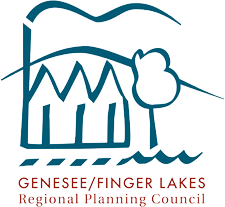Font Size
Green Infrastructure for Historic Districts
Genesee/Finger Lakes Regional Planning Council (G/FLRPC) has received partial funding through the Ontario County Water Resources Council’s 2013 Special Projects Fund to work on a project entitled, Green Infrastructure for Historic Districts. G/FLRPC, in cooperation with the Ontario County Soil and Water Conservation District (OC SWCD), will identify sites suitable for green infrastructure practices and techniques in the six National Register Historic Districts in Ontario County. These districts have been identified using New York State Department of Parks, Recreation and Historic Preservation data. Soil maps prepared by the Ontario County GIS Program will assist in these recommendations. Students from the Finger Lakes Institute –Community Design Center (FLI-CDC) will then create visual representations of the recommended green infrastructure practices and techniques.
Green infrastructure uses vegetation and soil to manage rainwater where it falls instead of using pipes to dispose of it in New York State waters. As a watershed develops, more impervious cover is created. Roads, buildings, parking, sidewalks, and driveways all increase runoff from rain events and snow melt. Stormwater runoff contains pollutants such as nutrients, pathogens, sediment, toxic contaminants, and oil and grease. Water quality problems generated by these pollutants have resulted with waterbodies such as lakes and streams having impaired or stressed uses. Green infrastructure reduces stormwater discharges and lowers pollutant loads.
Green and sustainable design has become increasingly popular in both the preservation and new construction industries due to public interest in energy conservation, water efficiency, and source reduction and waste management. Preservation and green goals overlap, and reconciling their differences is possible—provided that both sides strive to be as creative and flexible as possible. Preservation of natural features; permeable paving materials for parking lots, walkways, and driveways; driveway reduction; vegetated swales; rain gardens; green roofs; stormwater planters; rain barrels and cisterns; native vegetation; and downspout disconnection or extensions have been identified as green infrastructure practices and techniques that could easily be incorporated into historic districts with some guidance.
The primary goal of Green Infrastructure for Historic Districts is to provide assistance to municipalities and residents who wish to incorporate the concepts and practices of green infrastructure into their structures while maintaining the historic integrity of the individual buildings and the overall character of their community.
The final product will be a factsheet, pamphlet, brochure, or some other type of educational outreach material in addition to the renderings or site plans of the green infrastructure practices and techniques prepared by the FLI-CDC students. A presentation to all interested parties and participating communities will be provided at the end of Summer 2013.
Green infrastructure uses vegetation and soil to manage rainwater where it falls instead of using pipes to dispose of it in New York State waters. As a watershed develops, more impervious cover is created. Roads, buildings, parking, sidewalks, and driveways all increase runoff from rain events and snow melt. Stormwater runoff contains pollutants such as nutrients, pathogens, sediment, toxic contaminants, and oil and grease. Water quality problems generated by these pollutants have resulted with waterbodies such as lakes and streams having impaired or stressed uses. Green infrastructure reduces stormwater discharges and lowers pollutant loads.
Green and sustainable design has become increasingly popular in both the preservation and new construction industries due to public interest in energy conservation, water efficiency, and source reduction and waste management. Preservation and green goals overlap, and reconciling their differences is possible—provided that both sides strive to be as creative and flexible as possible. Preservation of natural features; permeable paving materials for parking lots, walkways, and driveways; driveway reduction; vegetated swales; rain gardens; green roofs; stormwater planters; rain barrels and cisterns; native vegetation; and downspout disconnection or extensions have been identified as green infrastructure practices and techniques that could easily be incorporated into historic districts with some guidance.
The primary goal of Green Infrastructure for Historic Districts is to provide assistance to municipalities and residents who wish to incorporate the concepts and practices of green infrastructure into their structures while maintaining the historic integrity of the individual buildings and the overall character of their community.
The final product will be a factsheet, pamphlet, brochure, or some other type of educational outreach material in addition to the renderings or site plans of the green infrastructure practices and techniques prepared by the FLI-CDC students. A presentation to all interested parties and participating communities will be provided at the end of Summer 2013.
- Brochures
- Canandaigua National Historic District
- Clifton Springs Sanitarium Historic District
- Downtown Geneva Historic District
- East Bloomfield Historic District
- Farmington Quaker Crossroads Historic District
- Green Infrastructure for Historic Districts in Ontario County, NY
- Genesee Park Historic District
- Geneva South Main Street Historic District
- Reports
- Resources
- National Register Historic Districts in Ontario County Map
- Ontario County GIS Program Soil Maps
- Canandaigua Historic District National Register Nominationhttp://www.oprhp.state.ny.us/hpimaging/hp_view.asp?GroupView=11025
- Clifton Springs Sanitarium Historic District National Register Nominationhttp://www.oprhp.state.ny.us/hpimaging/hp_view.asp?GroupView=55
- East Bloomfield Historic District National Register Nominationhttp://www.oprhp.state.ny.us/hpimaging/hp_view.asp?GroupView=49
- Farmington Quaker Crossroads Historic District National Register Nominationhttp://www.oprhp.state.ny.us/hpimaging/hp_view.asp?GroupView=101889
- Genesee Park Historic District National Register Nominationhttp://www.oprhp.state.ny.us/hpimaging/hp_view.asp?GroupView=10907
- South Main Street Historic District National Register Nominationhttp://www.oprhp.state.ny.us/hpimaging/hp_view.asp?GroupView=36
- New York State Stormwater Management Design Manual – Chapter 5: Green Infrastructure Practiceshttp://www.dec.ny.gov/docs/water_pdf/swdm2010chptr5.pdf
- New York State Stormwater Management Design Manual – Appendix H: Landscaping Guidance/Plant Lists -ttp://www.dec.ny.gov/docs/water_pdf/swdmappendixh.pdf
- The Secretary of the Interior’s Standards for Rehabilitation & Illustrated Guidelines on Sustainability for Rehabilitating Historic Buildings -http://www.nps.gov/tps/standards/rehabilitation/guidelines/index.htm
- National Register Bulletins
- Guidelines for Evaluating and Registering Cemeteries and Burial Placeshttp://www.nps.gov/nr/publications/bulletins/nrb41/
- How to Evaluate and Nominate Designed Historic Landscapeshttp://www.nps.gov/nr/publications/bulletins/nrb18/
- Guidelines for Evaluating and Documenting Rural Historic Landscapeshttp://www.nps.gov/history/nr/publications/bulletins/nrb30/
- Preservation Briefs
- Protecting Cultural Landscapes: Planning, Treatment and Management of Historic Landscapes http://www.nps.gov/tps/how-to-preserve/briefs/36-cultural-landscapes.htm
- Protecting Cultural Landscapes: Planning, Treatment and Management of Historic Landscapes http://www.nps.gov/tps/how-to-preserve/briefs/36-cultural-landscapes.htm
